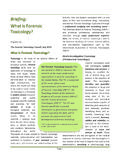Transcription of 80 exam questions general toxicology for practising
1 1 EIGHTY MODEL EXAM questions FOR practising (TOX-20303) 1. History of toxicology 1) What is toxicology ? (Indicate the one best answer). The field that studies the adverse effects on humans and animals. The field that studies the adverse effects of chemicals on living organisms. The field that studies the adverse effects of chemicals and microorganisms. The field that studies the risk-benefit balance of chemicals for living organisms. 2) Indicate which persons played an important role in the history of toxicology .
2 (Indicate all that apply). Hippocrates Atropa belladona Paracelsus Van t Hoff Rachel Carson St Anthony Orfila 3) Indicate which chemicals played an important role in the history of modern toxicology . (Indicate all that apply). Mercury Dioxins DDT Alcohol Softanon 4) Fill in the blanks. (Write your answer on the dots). a) The concept of dose in toxicology was introduced in by .. b) The target organ concept was introduced in toxicology by .. c) The affair with .. introduced emphasis on teratology and reproduction toxicology in safety testing of drugs and chemicals.
3 D) Modern toxicology especially developed because of the many new drugs, pesticides, munitions and industrial chemicals developed during the periods of the .. and .. 2 2. Principles of toxicology 5) Give the right sequential order of the following steps. (Number the steps from 1 to 4 on the dots). Risk assessment .. Hazard identification .. Risk management .. Hazard characterisation .. 6) Indicate what is true about the process of risk evaluation as defined by the FAO and WHO. (Indicate all that apply).
4 Risk assessment consists of risk characterisation, exposure assessment, risk management and risk communication. Risk assessment integrates hazard characterisation and exposure assessment. Risk management is part of risk assessment. Exposure assessment follows hazard characterization. Risk management follows risk assessment. 7) Match each description with its corresponding term. The terms may be used only once. Description Number of Term A. Integrating hazard characteristics with exposure data.
5 B. The probability that an adverse effect will occur.. C. Integrating risk assessment with social, economic and political aspects.. D. The molecular structure affected by a toxic agent.. E. A potential danger of a compound or a process.. 8) What is true about the process of risk assessment? (Indicate the one best answer). Acute exposure and chronic exposure from a chemical result in effects on a similar target organ, but only at a single high or a repeated low dose of exposure, respectively.
6 DNA can be a toxicological receptor. A dose response curve is important to establish the LD50 which is an important parameter in modern toxicological risk assessment. The LD50 is a constant parameter reflecting the acute toxicity of a chemical for different species. Term 1. risk assessment 2. hazard 3. receptor 4. risk 5. risk management 3 3. Mechanisms of toxicity 9) Match each type of chemical with its corresponding term describing a mechanism of toxicity. The terms may be used more than once or not at all.
7 Description Number of Term A. Compound causing lipid peroxidation.. B. Electrophile causing a DNA mutation.. C. Compound causing methemoglobinemia.. D. Compound inhibiting acetylcholinesterase.. E. Compound binding and activating an acetylcholine receptor in the same way as done by acetylcholine.. 10) What is true about mechanisms of toxicity? (Indicate all that apply). Methemglobinemia is caused by chemicals that cause electron transfer that oxidizes the Fe in hemoglobin from Fe2+ to Fe3+.
8 Lipid peroxidation is initiated by hydrogen abstraction. Reactive oxygen species (ROS) damage only unsaturated membrane lipids. Sarin and soman act by binding to the acetylcholine receptor An antagonist does not require structural similarity to the natural ligand to block the receptor. Inhibition of oxygen binding to hemoglobin by CO is an example of non covalent binding causing toxicity. 11) Which are chemicals acting by non-covalent interactions? (Indicate the one best answer). Sarin, soman, and acetylcholine agonists.
9 Benzo(a)pyrene and other genotoxic agents modifying DNA. Tetrodotoxin, saxitoxin and curare. Nitrate, reactive oxygen species and carbon monoxide. 12) What is true about reactive oxygen species (ROS)? (Indicate all that apply). In the Haber-Weiss reaction superoxide anions and hydrogen peroxide are converted to hydroxyl radicals. Reactive oxygen species cause formation of covalent DNA adducts. Reactive oxygen species are toxic because they are able to cause hydrogen abstraction. Reactive oxygen species are toxic because they cause non-covalent interactions with neurotransmitter receptor proteins.
10 Reactive oxygen species are toxic because they cause methemoglobinemia . Term 1. electron abstraction 2. hydrogen abstraction 3. covalent binding 4. agonist action 5. modulating action 4 4. Absorption, distribution and excretion of toxicants 13) What is true for ADME characteristics? (Indicate the one best answer). ADME characteristics describe what happens to a compound when it has entered the body. ADME characteristics describe the toxicodynamic phase. ADME characteristics determine the bioavailability of a compound upon oral intake.




